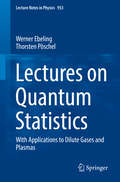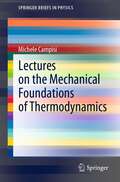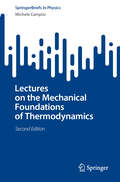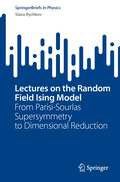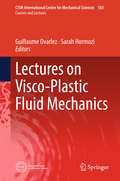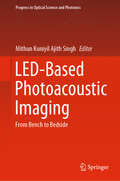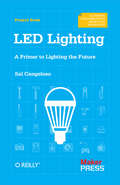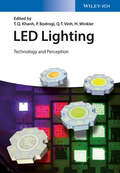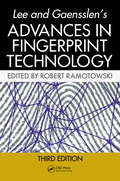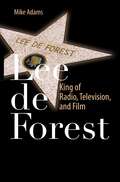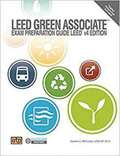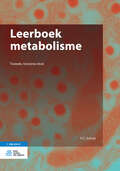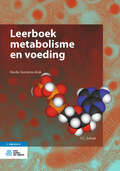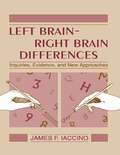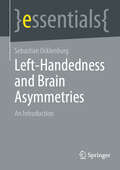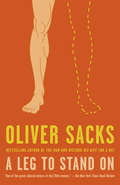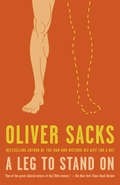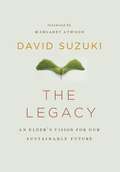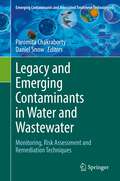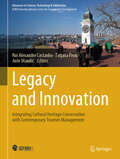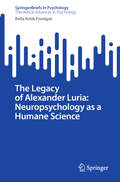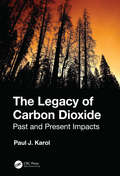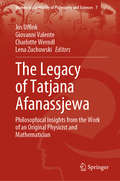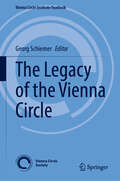- Table View
- List View
Lectures on Quantum Statistics: With Applications to Dilute Gases and Plasmas (Lecture Notes in Physics #953)
by Werner Ebeling Thorsten PöschelMost of the matter in our universe is in a gaseous or plasma state. Yet, most textbooks on quantum statistics focus on examples from and applications in condensed matter systems, due to the prevalence of solids and liquids in our day-to-day lives. In an attempt to remedy that oversight, this book consciously focuses on teaching the subject matter in the context of (dilute) gases and plasmas, while aiming primarily at graduate students and young researchers in the field of quantum gases and plasmas for some of the more advanced topics. The majority of the material is based on a two-semester course held jointly by the authors over many years, and has benefited from extensive feedback provided by countless students and co-workers. The book also includes many historical remarks on the roots of quantum statistics: firstly because students appreciate and are strongly motivated by looking back at the history of a given field of research, and secondly because the spirit permeating this book has been deeply influenced by meetings and discussions with several pioneers of quantum statistics over the past few decades.
Lectures on the Mechanical Foundations of Thermodynamics (SpringerBriefs in Physics)
by Michele CampisiThis brief provides a modern pedagogical exposition of the mechanical approach to statistical mechanics initiated by Boltzmann with his early works (1866-1871). Despite the later contribution by Helmholtz, Boltzmann himself (1884-1887), Gibbs, P. Hertz, and Einstein, the mechanical approach remained almost unknown to the modern reader, in favour of the celebrated combinatorial approach, developed by Boltzmann himself during his probabilistic turn (1876-1884). The brief constitutes an ideal continuation of a graduate course of classical mechanics and requires knowledge of basic calculus in many dimension (including differential forms), thermodynamics, probability theory, besides Hamiltonian mechanics. The cornerstone of the whole presentation is the ergodic hypothesis. Special attention is devoted to Massieu potentials (the Legendre transforms of the entropy) which are most natural in statistical mechanics, and also allow for a more direct treatment of the topic of ensemble equivalence.
Lectures on the Mechanical Foundations of Thermodynamics (SpringerBriefs in Physics)
by Michele CampisiThis book provides a modern pedagogical exposition of the mechanical approach to statistical mechanics initiated by Boltzmann with his early works (1866–1871). Despite the later contribution by Helmholtz, Boltzmann himself (1884–1887), Gibbs, P. Hertz, and Einstein, the mechanical approach remained almost unknown to the modern reader, in favour of the celebrated combinatorial approach, developed by Boltzmann himself during his probabilistic turn (1876–1884). The brief constitutes an ideal continuation of a graduate course of classical mechanics and requires knowledge of basic calculus in many dimensions (including differential forms), thermodynamics, and probability theory, besides Hamiltonian mechanics. The cornerstone of the whole presentation is the ergodic hypothesis. Special attention is devoted to Massieu potentials (the Legendre transforms of the entropy) which are most natural in statistical mechanics and also allow for a more direct treatment of the topic of ensemble equivalence. In this second edition, a chapter is added that addresses the long-debated question of how the second law of thermodynamics can be reconciled with mechanics, by using modern methods of non-equilibrium statistical mechanics.
Lectures on the Random Field Ising Model: From Parisi-Sourlas Supersymmetry to Dimensional Reduction (SpringerBriefs in Physics)
by Slava RychkovThis book is about the Random Field Ising Model (RFIM) – a paradigmatic spin model featuring a frozen disordering field. The focus is on the second-order phase transition between the paramagnetic and ferromagnetic phases, and the associated critical exponents. The book starts by summarizing the current knowledge about the RFIM from experiments, numerical simulations and rigorous mathematical results. It then reviews the classic theoretical works from the 1970’s which suggested a property of dimensional reduction – that the RFIM critical exponents should be the same as for the ordinary, non-disordered, Ising model of lower dimensionality, and related this an emergent Parisi-Sourlas supersymmetry. As is now known, these remarkable properties only hold when the spatial dimensionality of the model is larger than a critical dimension. The book presents a method to estimate the critical dimension, using standard tools such as the replica trick and perturbative renormalization group, whose result is in agreement with the numerical simulations. Some more elementary steps in the derivations are left as exercises for the readers. This book is of interest to researchers, PhD students and advanced master students specializing in statistical field theory.
Lectures on the Theory of Water Waves
by Thomas J Bridges Mark D. Groves David P. NichollsIn the summer of 2014 leading experts in the theory of water waves gathered at the Newton Institute for Mathematical Sciences in Cambridge for four weeks of research interaction. A cross-section of those experts was invited to give introductory-level talks on active topics. This book is a compilation of those talks and illustrates the diversity, intensity, and progress of current research in this area. The key themes that emerge are numerical methods for analysis, stability and simulation of water waves, transform methods, rigorous analysis of model equations, three-dimensionality of water waves, variational principles, shallow water hydrodynamics, the role of deterministic and random bottom topography, and modulation equations. This book is an ideal introduction for PhD students and researchers looking for a research project. It may also be used as a supplementary text for advanced courses in mathematics or fluid dynamics.
Lectures on Visco-Plastic Fluid Mechanics (CISM International Centre for Mechanical Sciences #583)
by Guillaume Ovarlez Sarah HormoziThe book is designed for advanced graduate students as well as postdoctoral researchers across several disciplines (e.g., mathematics, physics and engineering), as it provides them with tools and techniques that are essential in performing research on the flow problems of visco-plastic fluids. The following topics are treated: analysis of classical visco-plastic fluid modelsmathematical modeling of flows of visco-plastic fluidscomputing flows of visco-plastic fluidsrheology of visco-plastic fluids and visco-plastic suspensionsapplication of visco-plastic fluids in engineering sciencescomplex flows of visco-plastic fluids.
LED-Based Photoacoustic Imaging: From Bench to Bedside (Progress in Optical Science and Photonics #7)
by Mithun Kuniyil Ajith SinghThis book highlights the use of LEDs in biomedical photoacoustic imaging. In chapters written by key opinion leaders in the field, it covers a broad range of topics, including fundamentals, principles, instrumentation, image reconstruction and data/image processing methods, preclinical and clinical applications of LED-based photoacoustic imaging. Apart from preclinical imaging studies and early clinical pilot studies using LED-based photoacoustics, the book includes a chapter exploring the opportunities and challenges of clinical translation from an industry perspective. Given its scope, the book will appeal to scientists and engineers in academia and industry, as well as medical experts interested in the clinical applications of photoacoustic imaging.
LED Lighting: A Primer to Lighting the Future
by Sal CangelosoWe’re on the brink of a lighting revolution with light-emitting diodes—the tiny LEDs you’ve seen in electronic devices for years. With this practical guide, you’ll go behind the scenes to see how and why manufacturers are now designing LED devices to light everything from homes and offices to streets and warehouses.Author Sal Cangeloso shows you the working parts of a “simple” LED bulb and explains the challenges electronics companies face as they push LED lighting into the mainstream. You’ll learn how you can use LEDs now, and why solid state lighting will bring dramatic changes in the near future.Explore the drivers, phosphors, and integrated circuits in a typical LED bulbUnderstand the challenges in producing LED bulbs with acceptable brightness, color temperature, and power consumptionLearn about non-bulb LED applications, including lamps, street lights, and signageDiscover the market forces driving—and impeding—the adoption of LED lightingCompare LEDs to compact fluorescent lamps (CFLs) and electron-stimulated luminescence (ESL) bulbsGaze into the future of intelligent lighting, including networked lighting systems
LED Lighting
by Q. T. Vinh H. Winkler P. Bodrogi T. Q. KhanPromoting the design, application and evaluation of visually andelectrically effective LED light sources and luminaires for generalindoor lighting as well as outdoor and vehicle lighting, this bookcombines the knowledge of LED lighting technology with humanperceptual aspects for lighting scientists and engineers. After an introduction to the human visual system and currentradiometry, photometry and color science, the basics of LED chipand phosphor technology are described followed by specific issuesof LED radiometry and the optical, thermal and electric modeling ofLEDs. This is supplemented by the relevant practical issues ofpulsed LEDs, remote phosphor LEDs and the aging of LED lightsources. Relevant human visual aspects closely related to LEDtechnology are described in detail for the photopic and the mesopicrange of vision, including color rendering, binning, whiteness,Circadian issues, as well as flicker perception, brightness, visualperformance, conspicuity and disability glare. The topic of LEDluminaires is discussed in a separate chapter, including retrofitLED lamps, LED-based road and street luminaires and LED luminairesfor museum and school lighting. Specific sections are devoted tothe modularity of LED luminaires, their aging and the planning andevaluation methods of new LED installations. The whole is roundedoff by a summary and a look towards future developments.
Lee and Gaensslen's Advances in Fingerprint Technology
by Allan GawReflecting new discoveries in fingerprint science, Lee and Gaensslen‘s Advances in Fingerprint Technology, Third Edition has been completely updated with new material and nearly double the references contained in the previous edition. The book begins with a detailed review of current, widely used development techniques, as well as some older, histo
Lee de Forest
by Mike AdamsThe life-long inventor, Lee de Forest invented the three-element vacuum tube used between 1906 and 1916 as a detector, amplifier, and oscillator of radio waves. Beginning in 1918 he began to develop a light valve, a device for writing and reading sound using light patterns. While he received many patents for his process, he was initially ignored by the film industry. In order to promote and demonstrate his process he made several hundred sound short films, he rented space for their showing; he sold the tickets and did the publicity to gain audiences for his invention. Lee de Forest officially brought sound to film in 1919. Lee De Forest: King of Radio, Television, and Film is about both invention and early film making; de Forest as the scientist and producer, director, and writer of the content. This book tells the story of de Forest's contribution in changing the history of film through the incorporation of sound. The text includes primary source historical material, U.S. patents and richly-illustrated photos of Lee de Forest's experiments. Readers will greatly benefit from an understanding of the transition from silent to audio motion pictures, the impact this had on the scientific community and the popular culture, as well as the economics of the entertainment industry.
LEED Green Associate Exam Preparation Guide (v4 Edition)
by Heather C. McCombs<p>The LEED Green Associate Exam Preparation Guide, LEED v4 Edition is designed to help you pass the LEED Green Associate exam. The exam prep guide captures the critical points you need to know about green building. It also reflects the structure of the exam knowledge and task domains to organize foundational concepts in green building and LEED. <p>The exam prep guide will help you prepare for the exam by emphasizing key terms and providing application learning through practice questions. This resource is intended to be used in conjunction with the exam primary references, including the LEED Core Concepts Guide. Access to a variety of digital resources that enhance learning is also included with this guide.</p>
Leerboek metabolisme
by Frans C. SchuitMetabolisme of stofwisseling gaat over chemische reacties die brandstoffen omzetten in nuttige energie en bouwstenen vanuit de voeding opbouwen tot bestanddelen van het lichaam. Dit complexe gebeuren heeft grote invloed op gezondheid en ziekte en vormt daarom een onmisbaar onderwerp in de opleidingen geneeskunde, mondzorg en biomedische wetenschappen. Aan de ene kant is het belangrijk om te weten hoe het metabolisme normaal werkt en inspeelt op dagelijkse veranderingen in de voedingstoestand en fysische activiteit. Aan de andere kant zijn er specifieke stofwisselingsziekten maar ook complexe bijdragen van een veranderd metabolisme aan frequente ziekten zoals diabetes en kanker. De 2e herziene druk van Leerboek metabolisme bestaat uit twaalf hoofdstukken, verdeeld over twee gedeelten. Het eerste gedeelte bevat de kernleerstof en wordt ondersteund door 270 afbeeldingen, concrete leerdoelen en studeeraanwijzingen. Het tweede gedeelte gaat nader in op bepaalde onderwerpen en tast hierbij grenzen van wetenschappelijk verantwoorde vakkennis af, bespreekt de rol van pioniers in vroeger onderzoek, benoemt het belang hiervan voor huidige medische toepassingen en beschouwt het onderwerp vanuit de evolutieleer. Deze verdieping in de stof is herkenbaar gemaakt in gekleurde kaders en wordt ruim ondersteund door verwijzingen naar recente literatuur. De veelzijdige samenstelling van de informatie biedt studenten de mogelijkheid een leerpad te volgen dat bij de eigen interesse aansluit. Door de opzet fungeert het boek als een gids tijdens een reis naar het onafhankelijk en kritisch kunnen nadenken over een complex onderwerp. De speciaal voor deze druk ontwikkelde website met toetsvragen biedt de daarbij horende gebruiksvriendelijke verdieping en ondersteuning.
Leerboek metabolisme en voeding
by F.C. SchuitDit boek behandelt de belangrijkste aspecten van het menselijke metabolisme op een inzichtelijke manier. Het bespreekt de basisbegrippen, de complexe relatie tussen metabolisme en voeding en tussen metabolisme en ziektemechanismen. Het boek is bestemd voor studenten geneeskunde, mondzorg, farmacie en biomedische wetenschappen, hbo voeding en diëtetiek. De inhoud van het boek is verweven met een van de pijlers van de bachelorfase van de hiervoor vermelde opleidingen: de chemische basis van gezondheid en ziekte. Metabolisme gaat over chemische reacties die brandstoffen omzetten in nuttige energie en bouwstenen vanuit de voeding opbouwen tot bestanddelen van het lichaam. Het is belangrijk om te weten hoe het metabolisme normaal werkt en inspeelt op dagelijkse veranderingen in de voedingstoestand en fysische activiteit. Maar ook wat er speelt bij specifieke stofwisselingsziekten en de complexe bijdragen van een veranderd metabolisme aan frequente ziekten zoals diabetes en kanker.De derde herziene druk van Leerboek metabolisme en voeding bestaat uit twaalf hoofdstukken. De kernleerstof wordt ondersteund door 270 afbeeldingen, concrete leerdoelen en studeeraanwijzingen. In elk hoofdstuk staan ook verdiepende kaders over de grenzen van wetenschappelijk verantwoorde vakkennis, de rol van pioniers in vroeger onderzoek, het belang hiervan voor huidige medische toepassingen en beschouwingen uit de evolutieleer. Daarbij wordt steeds verwezen naar recente literatuur.Op de bijbehorende website zijn 300 toetsvragen, casussen en hot topics te vinden.
Left Brain - Right Brain Differences: Inquiries, Evidence, and New Approaches
by James F. IaccinoThis volume integrates past clinical findings with the latest research on cerebral asymmetry in order to identify why humans process information in different ways. A must for anyone who wants to understand human cognitive nature further, specifically the reasons why we are "wired" a certain way and whether these cortical circuits are flexible enough to be altered, this book presents the most up-to-date information on hemispheric differences within normal and clinical populations. Its focus on sex, handedness, and developmental differences is critical to the derivation of a better perspective on how future research should be conducted in this expanding science. Iaccino begins by explaining basic brain structures and types of cognitive styles assigned to each hemisphere. He then details studies involving various clinical populations -- psychophysiological, split-brain, dyslexic, and psychotic -- to support the claim that the two hemispheres are different, morphologically and functionally speaking. Applying this clinical research to the more normal population, the author uncovers striking cortical variations between the sexes and between the handedness groups, along with developmental changes which occur as a function of time. Finally, he provides a detailed summary of the previous chapters and highlights where asymmetrical research may be headed in the future.
Left-Handedness and Brain Asymmetries: An Introduction (essentials)
by Sebastian OcklenburgThis Springer essential provides an overview of current research on the topic of left-handedness and brain asymmetries. In addition to basics of assessing left-handedness and brain asymmetries, it also explores their evolution, development, and their study in the animal kingdom. Other focal points include research on the relationship between left-handedness and cognitive functions, as well as the topic of handedness and sports. The essential is rounded off with a discussion on the topic of relearning handedness and a discourse on altered asymmetries in various patient groups.
A Leg to Stand On
by Oliver SacksDr. Oliver Sacks&’s books Awakenings, An Anthropologist on Mars, and the bestselling The Man Who Mistook His Wife for a Hat have been acclaimed for their extraordinary compassion in the treatment of patients affected with profound disorders. In A Leg to Stand On, it is Sacks himself who is the patient: an encounter with a bull on a desolate mountain in Norway has left him with a severely damaged leg. But what should be a routine recuperation is actually the beginning of a strange medical journey when he finds that his leg uncannily no longer feels like part of his body. Sacks&’s brilliant description of his crisis and eventual recovery is not only an illuminating examination of the experience of patienthood and the inner nature of illness and health but also a fascinating exploration of the physical basis of identity. This 1984 classic is now available in an expanded edition with a new foreword, written by Kate Edgar, executive director of the Oliver Sacks Foundation.
A Leg to Stand On
by Oliver SacksHere the doctor becomes the patient, as Dr. Sacks chronicles the mountaineering accident which left him with the uncanny feeling of being "legless," and raises profound questions of the physical basis of identity.In A Leg To Stand On, it is Dr. Sacks himself who is the patient: an encounter with a bull on a desolate mountain in Norway has left him with a severely damaged leg. But what should be a routine recuperation is actually the beginning of a strange medical journey, when he finds that his leg uncannily no longer feels a part of his body. Sacks's description of his crisis and eventual recovery is not only an illuminating examination of the experience of patienthood and the inner nature of illness and health, but also a fascinating exploration of the physical basis of identity.
The Legacy
by Margaret Atwood David SuzukiIn this expanded version of an inspiring speech delivered in December 2009, David Suzuki reflects on how we got where we are today and presents his vision for a better future. In his living memory, Suzuki has witnessed cataclysmic changes in society and our relationship with the planet: the doubling of the world's population, our increased ecological footprint, and massive technological growth.Today we are in a state of crisis, and we must join together to respond to that crisis. If we do so, Suzuki envisions a future in which we understand that we are the Earth and live accordingly. All it takes is imagination and a determination to live within our, and the planet's, means. This book is the culmination of David Suzuki's amazing life and all of his knowledge, experience, and passion - it is his legacy.
Legacy and Emerging Contaminants in Water and Wastewater: Monitoring, Risk Assessment and Remediation Techniques (Emerging Contaminants and Associated Treatment Technologies)
by Paromita Chakraborty Daniel SnowThis volume provides a collection of research findings on the distribution and risk associated with emerging contaminants (ECs) in water and wastewater across the globe, and effective remediation techniques and technologies. The book covers various monitoring techniques for ECs in water and wastewater and its related impacts on the ambient environment, and offers valuable information on cost-effective monitoring techniques and sustainable treatment technologies for ECs. The authors detail the risks and biological effects of ECs and legacy persistent organic pollutants (POPs) in freshwater and marine systems, including their adverse interactions with aquatic organisms, while also discussing the associated impacts on human health. The book comprehensively covers current research outcomes on treatment methods, cost-effectiveness, and infrastructure needs for effective removal of ECs. It will be of interest to students, researchers, and scholars in environmental science and engineering, water and wastewater, toxicology, environmental biotechnology, soil sciences, and microbial ecology.
Legacy and Innovation: Integrating Cultural Heritage Conservation with Contemporary Tourism Management (Advances in Science, Technology & Innovation)
by Rui Alexandre Castanho Tatjana Pivac Ante MandićThis book explores the intersection of culture, sustainability, and tourism. Also, it explores the importance of integrating cultural heritage preservation, environmental sustainability, and economic considerations in the development of tourism destinations. It provides a deep understanding of how cultural tourism can be harnessed to create positive and responsible tourism experiences that benefit local communities, protect natural resources, and promote cultural diversity. Drawing upon real-world examples and case studies, this book offers practical strategies and approaches for fostering sustainable tourism practices. It examines the role of technology in enhancing cultural tourism experiences, the impact of tourism on local economies, and the preservation of cultural vitality in peripheral areas. The book also analyzes the implications of the Covid-19 pandemic on the tourism industry and explores sustainable development models for the post-pandemic era. With a multidisciplinary approach, this book is a valuable resource for tourism professionals, policymakers, researchers, and students interested in the field of sustainable tourism. It emphasizes the need for a balanced and holistic approach that considers the social, environmental, and economic dimensions of cultural tourism. By promoting cultural understanding, environmental stewardship, and inclusive community engagement, "Cultural Sustainable Tourism" paves the way for a more sustainable and responsible future in the tourism industry. This book provides a diverse range of case studies and research insights into various aspects of sustainable tourism. It offers valuable perspectives on community-based approaches, cultural preservation, the impact of the Covid-19 pandemic, destination modeling, heritage restoration, and the interconnections between tourism, media, and culture. Throughout the book, readers will find a wealth of case studies, research insights, and practical examples from around the world. These real-world examples offer valuable lessons and best practices for implementing sustainable cultural tourism initiatives. The book also encourages critical thinking and reflection, inviting readers to consider the ethical dimensions of cultural tourism, the importance of local empowerment, and the long-term sustainability of tourism practices.
The Legacy of Alexander Luria: Neuropsychology as a Humane Science (SpringerBriefs in Psychology)
by Bella Kotik-FriedgutThis book invites you into the remarkable life and enduring legacy of Alexander Romanovich Luria whose groundbreaking contributions to understanding of the human mind continue to reverberate through modern neuroscience and clinical practice. Drawing from previously unknown personal diaries, intimate family archives, and firsthand accounts from those who knew him best, this book depicts the man behind the science. Born in revolutionary Russia and navigating the tumultuous political landscape of the Soviet era, Luria emerged as a brilliant mind whose work transcended borders and ideologies. It is not merely a biography—it is an invitation to discover how one exceptional scientist's blend of brilliant observation, methodological innovation, and profound empathy created a legacy that continues to transform how we understand and treat neurological conditions today. The book highlights Luria's revolutionary contributions to neuropsychology, his unique "romantic science" approach, and the personal insights offered through previously unpublished materials. What made Luria truly exceptional was his refusal to reduce patients to clinical cases. Instead, he pioneered what he called "romantic science"—an approach that honored the whole person behind the neurological condition. This small book gives the reader in-depth analysis of two of Luria&’s celebrated case studies. The Mind of a Mnemonist and The Man with a Shattered World, including the &“afterlife&” of these books, showing that decades later, Luria's work remains essential reading for anyone seeking to understand the complex relationship between brain, mind, and human experience. Delving into personal accounts from Luria&’s students and collaborators highlights his pivotal role in shaping the global neuropsychology community. His visionary approach to education established him as a mentor who profoundly influenced generations, leaving an enduring legacy through his systemic-dynamic method. His influence continues to resonate today, as his students make his ideas accessible to a new generation of scientists through webinars, conferences, books, and journal publications, including the Lurian Journal.
The Legacy of Carbon Dioxide: Past and Present Impacts
by Paul KarolThe Legacy of Carbon Dioxide: Past and Present Impacts covers the truly varied roles carbon dioxide (CO2) has played and continues to play in the character of our planet. It examines the synthesis of CO2 in stars, the evolution of the atmosphere over billions of years, the chemical and physical properties of CO2, and how those influence common phenomena. <P><P>The author discusses how well this knowledge is understood and how it was determined, including existing uncertainties in our confidence and the stress from competing possibilities. It includes historical perspectives that illustrate the thinking about various scientific issues and their perceptions at the time. <P><P>Features: <li>Provides a historical panorama on how much the world has changed over the eons and the vast influence of carbon dioxide in these changes <li>Follows CO2 through acidic explosive waters, volcanic episodes, sequestered reservoirs, and the chemistry of life <li>Examines the broad scope of chemical and physical attributes carbon dioxide is capable of and their impacts <P><P>Much of the technological verbiage in various incorporated sciences has been modified to ease consumption by the non-expert. This book is a valuable resource for readers interested in the science of carbon dioxide as well as natural science, the environment, scientific methods, chemistry, and geological sciences.
The Legacy of Tatjana Afanassjewa: Philosophical Insights from the Work of an Original Physicist and Mathematician (Women in the History of Philosophy and Sciences #7)
by Jos Uffink Giovanni Valente Charlotte Werndl Lena ZuchowskiThis book presents a collection of essays that explore the life and works of Tatjana Afanassjewa (1876–1964), a Russian–Dutch physicist–mathematician. Readers will discover a scientist whose work on the foundations of thermodynamics significantly influenced the field itself as well as the philosophy of physics. This book highlights the philosophical consequences of her work in physics and mathematics and discusses historical aspects of her writings on the foundations of physics. In addition, it features English translations and critical reviews of key selections from her texts.First and foremost, the book highlights the numerous contributions that Afanassjewa made to the field. In particular, the authors examine her work on the foundations of thermodynamics and statistical physics, starting in the 1920s and extending to 1956, well after the untimely death of her husband in 1933. They also explore her almost entirely forgotten work on the didactics of mathematics. In addition, they discuss her influential collaboration with her husband, the Austrian physicist Paul Ehrenfest (1880–1933).The portrait that emerges is that of a highly original physicist and mathematician, whose legacy continues to influence scientists and philosophers today and whose lesser-known works deserve more attention than they have received. Readers will find a rich body of work that continues to this day to yield insights into the foundations of physics and mathematics.
The Legacy of the Vienna Circle (Vienna Circle Institute Yearbook #30)
by Georg SchiemerThis book gives a critical evaluation of the Vienna Circle, its historical influences, and the philosophical legacy of logical empiricism. The first part of the volume contains nine original research articles by leading experts in the field on the philosophical work of Rudolf Carnap, Philipp Frank, Otto Neurath, Janina Hosiassion-Lindenbaum, Susan Stebbing, and Gustav Hempel (among others) and their respective influence on subsequent developments in philosophy and the science studies. Topics addressed in the volume include: scientific humanism and non-cognitivism, scientific pluralism, the post-war reception of Logical Empiricism, relativism and the sociology of science, inductive reasoning and probability theory, as well as aspects of logical theory reconstruction. This book is of relevance to scholars and advanced students interested in the history of logical empiricism and the history of philosophy of science more generally.
